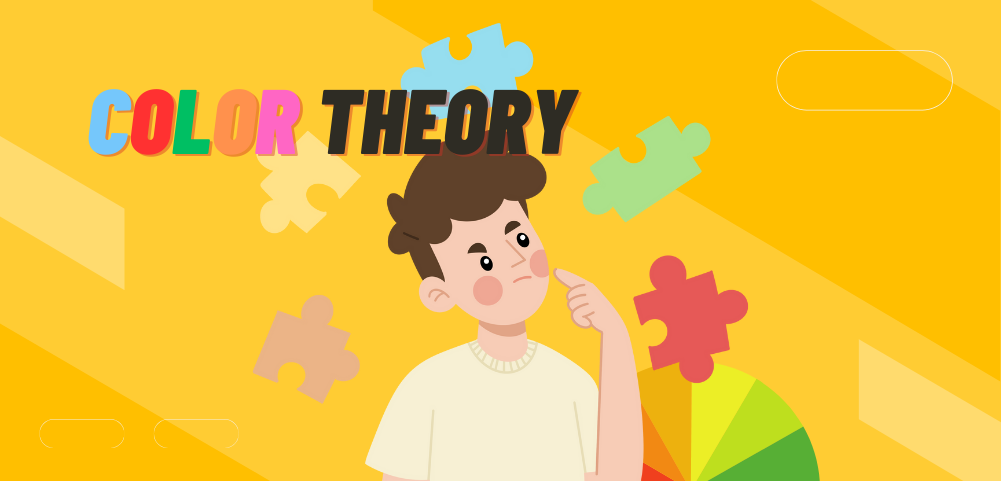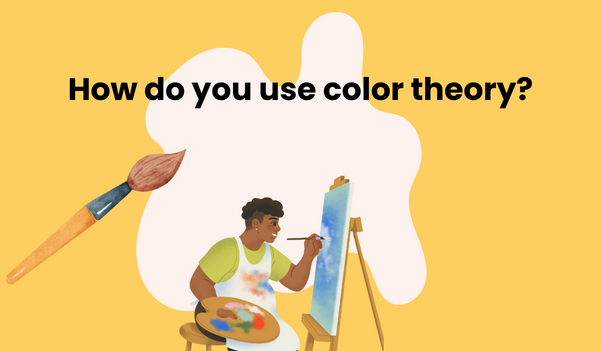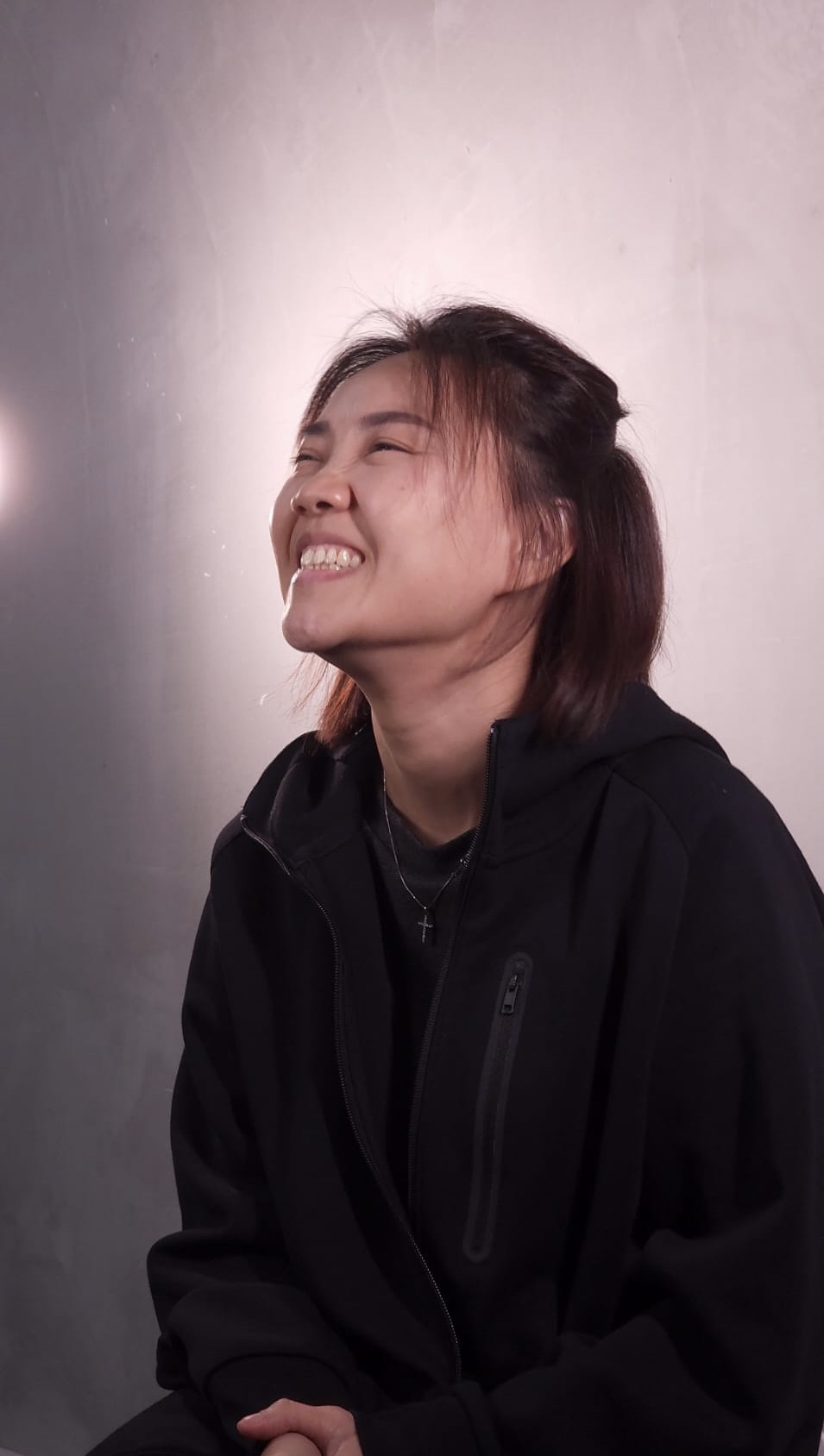A Guide To Color Theory
by Arthur Yang September 20, 2023

Humans are visual creatures—we are attracted to bright, large and loud images.
Understanding color theory can help you explain why some images are more attractive than others, and help your products and designs stand out amongst competitors .
In this color theory guide, we’re here to break it down into bite-sized pieces for you to start applying these concepts immediately.
A Guide In Color Theory Topics :
A guide to color theory
A Guide To Color Theory
1. What is color theory?
2. How do you use color theory?
3. Introduction to monochromatic colors
4. Can a color blind person become a graphic designer
5. An inspiring Story – Deafblind Student Who Loves Art
6. Conclusion
Let’s go!
A Guide to Colour Theory
What Is color theory?
A Guide To Color Theory
#1 — Why are the primary colors important?
Color theory is the science and art of using colors. It involves understanding how colors interact, blend, and evoke emotions.
Primary colors are like the building blocks of all other colors.
You can’t make these colors by mixing others. When you mix them, you get new colors.
These primary colors are essential because they help us create all the different colors we see around us!
Every color in the spectrum can be derived from different combinations of these primary hues.
In the realm of art and design, understanding primary colors provides the essential building blocks for creating a vast array of shades and tones, allowing artists to express their creativity with depth and richness.
This intrinsic property makes them the cornerstone of color theory.
#2 — What are the real primary colors?
A Guide To Color Theory
In the classical model of color theory, red, blue, and yellow are the authentic primary colors.
Through the process of color mixing, these primary colors give birth to secondary colors: red and blue produce purple, blue and yellow yield green, and red and yellow create orange.
These secondary colors, in turn, combine with primary colors to form tertiary colors, forming a comprehensive spectrum of hues.
This structured approach not only guides artists but also serves as the foundation for various industries, including graphic design, interior decoration, and fashion, ensuring consistent and harmonious color choices.
#3 — Is it possible to create a new primary color?
The concept of primary colors hinges on their indivisibility.
No amalgamation of other colors can replicate the unique attributes of true primary colors.
In recent years, advancements in scientific understanding and technology have led to discussions about the possibility of creating new primary colors.
However, these discussions often revolve around the context of specific color models and applications.
For instance, in digital displays, researchers have explored the concept of additional primary colors to enhance the range and accuracy of colors that can be displayed.
These new colors, such as cyan and magenta in addition to red, green, and blue, are called extended primary colors.
While these innovations expand the color gamut, they do not alter the fundamental concept of traditional primary colors, which remain fixed as the foundation upon which all other colors are built.
In essence, the traditional primary colors remain immutable and essential in color theory, serving as the basis for artistic expression, design, and various other fields where the understanding and manipulation of colors are paramount.
#4 — How are primary colors formed?
Primary colors find their origins in the physics of light and the chemistry of pigments.
Light-based primary colors, known as additive colors, combine to form a broad spectrum of hues in technologies such as television screens and digital displays.
On the other hand, pigment-based primary colors, known as subtractive colors, blend in processes like painting and printing.
Understanding the distinction between these models enables artists and designers to choose the appropriate color system for their specific mediums, ensuring the accurate representation of their creative vision.
#5 — Is color theory subjective?
Color theory itself is not subjective; it provides objective principles and guidelines for understanding how colors interact and influence human perception.
These principles are rooted in the physics of light, human biology, and psychology.
For example, complementary colors create contrast because they stimulate different cones in the human eye, while warm colors like red and orange tend to evoke feelings of warmth and energy due to the way our brains process those wavelengths.
While the principles of color theory remain consistent, their interpretation and emotional impact can vary from person to person, making the overall experience of color somewhat subjective.
Human response to specific colors are influenced by cultural, personal, and psychological factors.
Different cultures may associate colors with different meanings.
Additionally, personal experiences and preferences can shape an individual’s perception of colors.
For example, one person might find comfort in the color blue, associating it with calmness, while another might find it cold or depressing.
In the application of color theory, artists and designers often consider these subjective factors to create designs that resonate with specific audiences.
By adhering to these principles, artists and designers can create visual compositions that resonate universally, transcending individual subjectivity.
How do you use colour theory?

After introducing color theory, let’s talk about how you can use it!
#1 — Why is color theory important
A Guide To Color Theory
Color theory holds immense significance both in everyday life and design, functioning as a silent yet powerful communicator.
In both contexts, colors possess the remarkable ability to convey messages without the use of words.
Our perception of colors is influenced by a complex interplay of personal preferences, gender, family background, and cultural identity.
Many everyday choices, especially buying decisions, are significantly influenced by visual cues.
In marketing, colors are strategically employed to create brand awareness, associating specific emotions and concepts with a particular brand.
For artists and designers, comprehending color definitions and how they influence viewers’ impressions is indispensable.
Colors carry both positive and negative connotations, making it essential to choose them judiciously.
Whether evoking feelings of trust and excitement or caution and apprehension, colors serve as a language of their own, guiding perceptions and shaping the way individuals interact with the world around them.
Therefore, mastering color theory is not just an artistic endeavor but a profound understanding of human psychology and communication.
#2 — How do you read the colour wheel?
The color wheel is a visual representation of colors arranged in a circular format.
It is a fundamental tool used in art, design, and various creative fields to understand color relationships and create visually harmonious compositions.
Here’s how to read and interpret the color wheel:
Primary Colors: The color wheel starts with the three primary colors: red, blue, and yellow.
These colors are pure and cannot be created by mixing other colors.
Secondary Colors: Between the primary colors are the secondary colors: orange (red + yellow), green (yellow + blue), and purple (blue + red).
Secondary colors result from mixing equal parts of adjacent primary colors.
Tertiary Colors: Tertiary colors are formed by mixing a primary color with a neighboring secondary color.
For example, combining red and orange creates red-orange, a tertiary color.
Complementary Colors: Colors opposite each other on the color wheel are complementary.
Complementary pairs, like red and green or blue and orange, create strong contrast when placed together, making each color appear more vibrant in the presence of the other.
Analogous Colors: Analogous colors are next to each other on the color wheel, such as blue, blue-green, and green.
These colors harmonize well and are pleasing to the eye when used together in a design.
Warm and Cool Colors: Colors on one half of the wheel (red through yellow-green) are considered warm, evoking feelings of energy and warmth.
Colors on the other half (green through violet-red) are cool, suggesting calmness and serenity.
Tints, Shades, and Tones: Tints are created by adding white to a color, making it lighter.
Shades are made by adding black, darkening the color.
Tones result from adding gray, desaturating the color.
These variations add depth and complexity to a color scheme.
Split-Complementary and Triadic Colors: Split-complementary colors use a base color and the two adjacent to its complementary color.
Triadic colors are evenly spaced around the color wheel, such as red, yellow, and blue.
These schemes offer balance and contrast in designs.
By understanding the color wheel, artists and designers can choose harmonious color palettes, create visual interest, and convey specific emotions or messages effectively.
It serves as a valuable tool for anyone working with colors, providing a structured way to explore and experiment with different combinations, ultimately enhancing the visual impact of their creations.
#3 — Effective ways to use color in art and design
A Guide To Color Theory
Mastering the art of color in design is essential for creating visually captivating and emotionally resonant compositions.
By understanding the principles of color theory and its psychological impact, designers can craft compelling visuals that leave a lasting impression on their audience
Create Emotional Impact: Colors evoke emotions and can set the tone for a design.
Warm colors like red, orange, and yellow create energy and excitement, while cool colors like blue and green evoke calmness and tranquility.
Choose colors that align with the emotions you want your design to convey.
Enhance Readability: Contrast is essential for readability.
Ensure that there is enough contrast between text and background colors to make the text easily readable.
High contrast between text and its background improves legibility and ensures the message is communicated effectively.
Convey Brand Identity: Consistent use of specific colors in branding helps create brand recognition.
Companies often have a specific color palette associated with their brand.
Using these colors consistently across various designs reinforces the brand identity and makes the brand more memorable to the audience.
Explore Color Harmonies: Understanding color harmonies, such as complementary, analogous, or triadic schemes, helps create visually pleasing designs.
Complementary colors (opposite on the color wheel) create high contrast, while analogous colors (next to each other on the wheel) offer harmony.
Experimenting with these harmonies can add depth and sophistication to your designs.
Consider Cultural Associations: Different cultures associate colors with various meanings.
For instance, white represents purity and weddings in some cultures but symbolizes mourning in others.
Be mindful of these cultural associations, especially if your design is intended for a global audience.
Use Color Psychology: Color psychology explores the impact of colors on human emotions and behavior.
For example, blue is often associated with trust and reliability, making it suitable for corporate designs.
Understanding these psychological effects can help you choose colors that resonate with your target audience.
Experiment with Color Combinations: Don’t be afraid to experiment with unconventional color combinations.
Sometimes, unexpected pairings can create striking and memorable designs.
Tools like color wheels and online color palette generators can assist you in finding unique and harmonious combinations.
Effective use of color in design is a balance between creativity and understanding the psychological and cultural contexts in which your designs will be perceived.
By considering these factors, you can create visually appealing and impactful designs.
#4 — Creating contrast using color in design
A Guide In Color Theory
Contrast in design is the deliberate differentiation of one element from others within a layout, strategically implemented to capture the viewer’s attention.
This technique is pivotal in emphasizing key messages and guiding the viewer’s focus.
Choosing the Right Color Combinations
Selecting appropriate color combinations is key.
Conflicting colors may distract or confuse viewers, while complementary colors harmonize naturally, creating a visually pleasing effect.
Vibrant hues attract attention, while subtle contrasts provide sophistication.
Understanding color theory helps in choosing the perfect hues for contrast.
Reinforcing ideas through colors
Colors carry meanings and emotions.
Using them thoughtfully reinforces ideas and messages within your design.
For instance, warm tones like red and orange can signify energy and urgency, while cool blues evoke calmness.
Aligning the color palette with the intended message strengthens the overall communication.
Establishing hierarchy with colors
Color contrast establishes hierarchy within a layout.
By varying colors strategically, you indicate the importance of different elements.
The focal point, often in bold or vibrant colors, immediately captures attention.
Subordinate details, in softer tones, fade into the background, creating a seamless visual flow.
This hierarchy guides the viewer’s focus, ensuring they absorb information in the desired order.
Balancing boldness and subtlety
Effective color contrast strikes a balance between boldness and subtlety. While vibrant colors draw attention, an overload can overwhelm. Combining bold contrasts with subtler shades ensures harmony. Experiment with intensity, saturation, and placement to achieve the perfect equilibrium, creating a visually engaging but not overpowering design.
Consistency across platforms
Maintaining consistent color contrast is crucial, especially in branding.
Colors become associated with a brand’s identity.
Consistency in color usage across various platforms—be it websites, social media, or print materials—strengthens brand recognition.
It ensures that the audience receives a cohesive visual experience, reinforcing the brand’s message effectively.
Introduction to monochromatic color
A Guide To Color Theory
Monochromatic colors are easy to create because they only use one color.
Let’s see how we can use them!
#1 — What is a monochromatic color scheme?
A monochromatic color scheme is a design approach centered around a single base color tint.
In this scheme, various shades, tones, and hues of the chosen color are utilized, achieved by altering the saturation and brightness.
The palette also includes black and white, the extremes of the spectrum.
Despite being built around a single color, a monochromatic scheme is not limited to a single shade.
Instead, it explores the depth of the chosen hue, creating visually captivating designs through subtle variations.
#2 — What are some examples of monochromatic colors?
A Guide In Color Theory
A prime example of a monochromatic color scheme can be witnessed in Wes Anderson’s film “The Grand Budapest Hotel.”
Anderson masterfully utilizes varying shades of pink, creating a visually stunning and cohesive look throughout the movie.
Denis Villeneuve’s thriller “Enemy” employs a bold yellow monochromatic scheme, enhancing the film’s enveloping sense of dread.
Another striking example can be found in Zhang Yimou’s “The Shadow,” where a black-and-white monochromatic palette is used to perfection, adding depth and elegance to the visual narrative.
Additionally, Netflix’s series “Ozark” utilizes a pervasive blue tint, enveloping the entire show in an atmospheric and intense ambiance.
#3 — How do designers use Monochromatic Color Scheme?
Designers employ monochromatic color schemes to create visually unified and aesthetically pleasing designs.
By exploring the subtle variations within a single hue, designers evoke specific emotions and establish unique visual identities.
The limited color palette simplifies the decision-making process, allowing designers to focus on other aspects of the design, such as layout and typography.
Monochromatic schemes are particularly effective when designers want to convey a specific mood or atmosphere.
The meticulous use of shades and tones adds depth to the design, guiding the viewer’s focus and creating a harmonious visual experience.
In summary, monochromatic color schemes showcase the artistic finesse of designers, allowing them to transform a single color into a myriad of shades, tones, and emotions.
From films to graphic design, this approach exemplifies the power of subtlety, proving that within a single hue, endless possibilities and captivating visuals await.
Can a color blind person become a graphic designer?
A Guide In Color Theory
#1 — What exactly is Color Blindness?
Color blindness, also known as color vision deficiency, is a visual impairment characterized by the inability to perceive certain colors accurately.
This condition occurs when the cells in the retina that are responsible for detecting different wavelengths of light are defective.
People with color blindness may have difficulty distinguishing specific colors, particularly red and green hues, or in severe cases, seeing colors at all.
#2 — Symptoms of Color Blindness
Color blindness varies in severity.
While some individuals may have mild difficulty with specific shades, others may struggle with a broader range of colors.
Although color blindness is generally a genetic condition, it can also be caused by certain eye diseases, injuries, or aging.
Here are some symptoms of color blindness.
1. Limited Color Perception: Color blind individuals often struggle to differentiate between specific colors, especially red and green shades.
This limitation can affect their ability to recognize traffic lights, certain fruits, or color-coded information.
2. Monochromacy: In rare cases, individuals with color blindness may see the world in shades of gray, black, and white, a condition known as monochromacy.
This extreme form of color blindness results in a complete absence of color vision.
3. Difficulty with Color-Coded Information: Color blindness can make it challenging to interpret color-coded data, maps, or charts accurately.
For instance, understanding graphs that use different colors to represent distinct information categories can be problematic.
4. Confusion Between Colors: Some individuals may confuse similar-looking colors, such as mistaking blue for purple or green for brown.
This confusion can lead to misunderstandings in various contexts, including fashion and art.
5. Problems with Red-Green Perception: The most common type of color blindness involves difficulty distinguishing between red and green hues.
Affected individuals may see these colors as shades of gray or other colors, impacting activities like choosing ripe fruits or matching clothing.
#3 — Three Important things as a Colorblind Designer
For colorblind designers, navigating the intricacies of color theory and accurate color selection can present unique challenges.
In this comprehensive guide, we delve into the world of color, offering valuable insights and practical solutions tailored to the specific needs of colorblind designers.
From understanding the psychological impact of colors to mastering color combinations and selection techniques, this guide addresses the core aspects of working with color in design.
Whether you’re a seasoned professional or an aspiring designer, these strategies and tools will empower you to create captivating designs, ensuring your color choices are not only accurate but also aesthetically pleasing.
1. Color Matching:
Colors are experienced differently by individuals, both technically and emotionally.
Psychological reactions to colors emphasizes the importance of color matching in eliciting specific emotions and creating visually pleasing designs.
Colorblind designers should still use the color wheel and combinations to create harmonious palettes.
There are various online platforms that empower colorblind designers, allowing them to present diverse color palettes to clients.
These tools simplify the selection process and ensure the chosen colors align seamlessly with existing brand palettes.
2. Selecting Colors Correctly:
Colorblind designers face challenges in selecting colors in various software interfaces.
To make the search easier, they can utilize existing colour systems like HSB, RGB, HEX, and CMYK to get more accurate colour selection.
By understanding these systems, colorblind designers can confidently select colors and ensure precision in their work.
Alternatively, color codes can be used to accurately identity a specific tint of color.
These methods can empower designers to access a wide array of color options without the constraints of color blindness.
3. Testing Colors with Available Tools:
There are essential tools like WhatColor and ColorNamePicker, specifically designed for colorblind designers.
These tools facilitate color verification, ensuring that the chosen colors align with the intended visual design.
The Eye dropper extension and color name stickers, also offer practical solutions for real-time color selection and quick reference.
By equipping colorblind designers with this comprehensive knowledge, we hope that they can foster confidence, creativity, and precision in their design endeavors.
With a deeper understanding of color theory and access to the right tools, every colorblind designer can create visually captivating and emotionally resonant designs.
An inspiring Story – Deafblind Student Who Loves Art
Midjourney – A Basic Guide For Beginners
Despite the difficulties of doing design and art as a colorblind person, we have had a former student who went through our Digital Art with Procreate course and is now doing art herself.
Look out for her story below!
#1 — A real passion for art (Introduction of Faith)
Faith discovered her visual impairment at the age of 30, unaware of her condition all along.
She had perceived the world through a dreamy, cloudy lens, considering it normal.
Also, her vision and hearing ability is slowly reducing, and she will be fully deafblind in a matter of months.
Despite her difficulties, Faith has a deep passion for art and drawing.
This was when the Deaf Association reached out to us, seeking a suitable course for her.
Luckily, we were able to offer her a course in Digital Art with Procreate, a platform she eagerly embraced due to her sheer determination and will.
She has since found her passion for digital art as it allows her the option to zoom in and colour pixels individually, bypassing her vision impairment.
#2 — What does the world look/sound like to deafblind people?
Growing up, Faith has perceived her world as dreamy and cloudy, completely unaware that she had a vision impairment.
Her first idea that she might have a hearing impairment came at Primary Four.
During a listening comprehension, she realised that she was unable to hear any audio, after-which a nurse encouraged her to visit the hospital for a check-up.
However, it was not until the age of 30 when she realised that she had a vision impairment as well.
#3 — An inspiration to us all
Faith found solace and purpose in creating art before her light fades completely.
Driven by her devotion to Christianity, she managed to find strength to pursue her creative endeavor with courage and determination.
Our team at Hustle were deeply moved by her story, and felt honored to be able to assist her in her creative journey.
Amidst the challenges, Faith’s unwavering spirit and the support she received from the community have become a testament to the power of art, resilience, and the human spirit.
Her story is a tale of courage, determination, and the unwavering pursuit of creativity, painting a vivid picture of the human capacity to find light even in the darkest of times.
Conclusions and Next Steps
A Guide To Color Theory
Faith’s story has been a true inspiration for our team and has given us meaning in the work that we do.
With the skills learnt from our course, Faith hopes to make a living out of digital art to support herself and to inspire people around her.
She also expresses her gratitude to our trainer, Shanique, for her patience and kindness in guiding her through the course.
If you are inspired by Faith’s story and interested to learn more about Color Concepts through Skillsfuture Eligible WSQ course, you can find out more here – Acrylic Color Application.
You can also contact us via the chatbot or simply drop us a DM on our Instagram page if you’d like to know more about our courses
. . . . .



